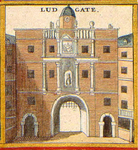Farringdon Within
Use British English from November 2014Wards of the City of London

Farringdon Within is one of the 25 wards of the City of London, the historic and financial centre of London. It was formed in the 14th century from the sub-division of the pre-existing Farringdon Ward into Farringdon Within (inside the line of the Former London Wall), and Farringdon Without, beyond the Wall. Farringdon Without and Farringdon Within are unconnected to the Farringdon area to the north, outside the City, in Clerkenwell. Southern Clerkenwell is sometimes referred to as Farringdon due to the presence of Farringdon Station, which was named after Farringdon Street and originally named Farringdon Street Station.
Excerpt from the Wikipedia article Farringdon Within (License: CC BY-SA 3.0, Authors, Images).Farringdon Within
Limeburner Lane, City of London
Geographical coordinates (GPS) Address Nearby Places Show on map
Geographical coordinates (GPS)
| Latitude | Longitude |
|---|---|
| N 51.51438 ° | E -0.10343 ° |
Address
City Thameslink
Limeburner Lane
EC4M 7AX City of London
England, United Kingdom
Open on Google Maps









